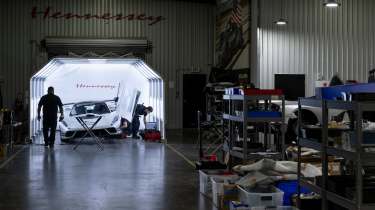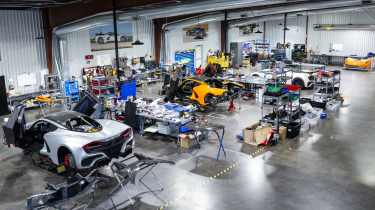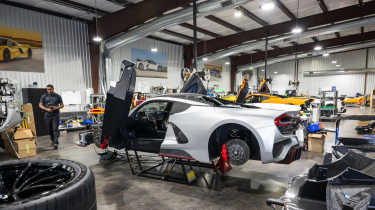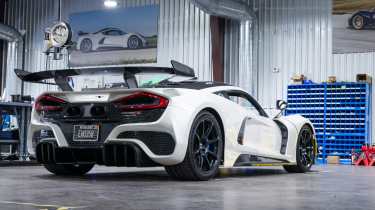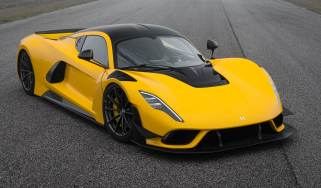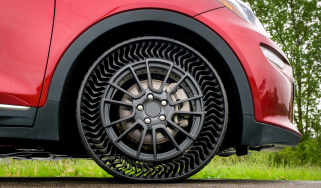Inside Hennessey: How America's Bugatti fighter is built
Hennessey’s story is one of escalation. We visit Texas to find out how a tuner became a hypercar heavy hitter
The story of Hennessey Performance is steeped in speed. It started with founder John Hennessey’s early forays to Pikes Peak, Bonneville Speed Week and the Silver State Challenge in his self-built Mitsubishi 3000GT, quickly progressing to tuned Dodge Vipers that punched through the 200mph barrier and established the Hennessey brand as a force to be reckoned with.
Since then, a succession of outrageously powerful cars, trucks and SUVs has reinforced Hennessey’s position as one of America’s largest and most enduring tuning companies. As a brand synonymous with tyre-smoking, ultra-boosted muscle cars with names like Marvel characters – The Exorcist, VelociRaptor, Super Venom – Hennessey’s portfolio embodies a gung-ho, more-is-more ethos that’s unashamedly American and very hard to resist.
But there’s another side to Hennessey. One that has gone beyond tuning other makers’ cars and seen the company evolve into a hypercar maker with boundless ambition and a growing team of world-class talent.
After many small steps, the first giant leap towards becoming a car maker was made in 2010 when the Hennessey Venom GT was unveiled at the SEMA show. Loosely based on the S2 Lotus Exige, the Venom GT was powered by an all-American twin-turbo 7-litre, 1244bhp, 1155lb ft V8 mated to the Ford GT’s slick-shifting six-speed manual transmission.
Weighing just 1244kg, it was a truly ballistic device. No surprise there. That it was also extremely well resolved was less expected, but something we discovered first-hand as one of the very few magazines to drive it – on road and runway – in Texas back in early 2013 (evo 180).
No question, the Venom GT deserves to be remembered for more than its raw speed. Still, as claims to fame go, achieving a Vbox-verified 270.49mph at the Kennedy Space Center (before running out of runway while still accelerating) back in 2014 isn’t a bad one. For a while that achievement made it the world’s fastest street-legal car, albeit unofficially due to not running in both directions. Semantics notwithstanding, that 270mph run propelled Hennessey into the very highest echelon. One in which they would be mentioned in the same breath as Bugatti and Koenigsegg.
Since then, this trio has enjoyed taking turns to outdo each other in the pursuit of ‘world’s fastest’ glory with a succession of extraordinary machines. First, in 2017, the Koenigsegg Agera RS nailed a two-way average of 277.87mph on a closed stretch of public highway in Nevada, with a one-way peak of 285mph. Then, in 2019, Bugatti topped it with a 304.77mph one-way run at the Ehra-Lessien test track in a Bugatti Chiron Super Sport.
In late 2020, SSC North America crashed the party with the highly impressive Tuatara hypercar, making a remarkable but ultimately discredited 331.15mph run along the same stretch of Nevada highway used by Koenigsegg.
After the inevitable internet meltdown, SSC regrouped, acknowledged its mistakes and came back in early 2021, setting a two-way Racelogic-verified average of 282.9mph at the Kennedy Space Center. This was followed by a one-way peak of 295mph during a later test session at the same facility in 2022. The Tuatara is clearly a rocketship, but with apparently very few cars built, for now the greater challenge for SSC is achieving production car status.
It’s the increasingly fierce battle to be the first to achieve a two-way average above 300mph that has brought us back to the US, for a visit to Hennessey’s home in Sealy, Texas. Arriving at Hennessey’s HQ, you’re struck by the sheer size of the campus. Comprising 142 acres of land, 5000 square metres of buildings, a drag strip, a small network of perimeter roads and endless parking, it’s like a ranch for horsepower.
The sheer quantity of vehicles parked around the place is mind-boggling. Whether awaiting transformation or ready for collection, everywhere you look there’s a Mustang Dark Horse, Challenger Hellcat, Cadillac CT5-V Blackwing or Camaro ZL1. And then there are the Raptors and Rams that tower over everything. If you love muscle cars and super-trucks, this place is off the scale.
Somewhat hilariously, pretty much everything appears to have been tuned to 1000bhp. Then again, if you’re bringing your car to a place that’s also in the business of building halo hypercars with twice that power, perhaps it’s no wonder perspective gets a little bent out of shape when you drive through the gates.
There’s nothing fancy about the premises. But then Hennessey remains a tuning shop by volume, even if it’s firmly in the hypercar sphere by achievement, reputation and aspiration. Some people might expect more glitz and glamour to go with their £2million hypercar, but Hennessey’s humble beginnings and unpretentious style are true to the company’s straight-talking Texan roots. It all exudes a pleasing authenticity. One that places its emphasis on delivering the goods, not creating an Insta-fabulous illusion or selling vaporware.
> The £2.2m Hennessey Venom F5 Evolution has twice the power of a Bugatti Veyron
Shortly before our visit, Hennessey had signed what could prove to be a transformative bipartisan deal with Ford, GM and Stellantis. In a nutshell it means Hennessey-modified cars can now be ordered directly from each brand’s US dealerships. It also allows for those dealers to order Hennessey models for themselves and sell the physical cars directly from their showrooms.
These so-called bailment builds stand to double Hennessey’s output from a little over 500 vehicles per annum to somewhere north of a thousand in the space of a year. I put it to John Hennessey that this is his Cayenne moment: the major uplift in business that will allow increased investment in future projects and the ability to indulge in more high-octane adventures. Encouragingly, he doesn’t disagree.
The quest to build a production hypercar capable of breaching 300mph presents a unique dichotomy: pointless pursuit to the unenlightened, but the noblest and most thrilling of enterprises for those of us raised on The Right Stuff. Whichever way you slice it, the compulsion to be the fastest stems from the same impulse that has inspired and motivated engineers since the invention of the wheel.
Still, it might appear hypocritical to celebrate such endeavours when all we seem to do is complain about how modern cars are way too quick already. The very fastest cars are different. Exempt from conventional wisdom because they exist in another realm. One only a handful of drivers – professional development drivers at that – are ever likely to experience, yet one that captures our collective imagination like little else. Even in failure they find a kind of glory, but immortality awaits those who succeed.
For John Hennessey, what began as a wildly ambitious dream quickly became something akin to an obsession. He describes the Venom F5 programme as ‘the hardest thing I’ve ever done in my life, period’, adding that if he knew what he knows now he probably wouldn’t have done it. It’s classic speed-junkie’s remorse. Even as he’s describing the scale of the challenge, the glint in his eye tells you he wouldn’t change a thing.
He’s been here before, of course, with the Venom GT. But where that car was a brilliantly executed hot-rodder’s fever dream, the Venom F5 required a wholesale change in approach. Partly because Hennessey wished to silence those who couldn’t get beyond the GT’s use of a Lotus tub and chose to overlook the wholesale re-engineering work that had gone on beneath the familiar styling. But mostly because to push to 300mph and beyond demanded a clean-sheet project that was bespoke from its wheels up.
It would also require whole-vehicle expertise, ideally possessed by key members of in-house personnel, plus forging closer ties with world-leading technical partners. After a very early styling render was revealed in 2014, the Venom F5 steadily became the prism through which Hennessey focused its efforts to attract exceptional talent. In 2017, Hennessey Special Vehicles (HSV) was founded with the express mission of designing, engineering and building the world’s fastest production car. A full-scale exterior-styling show car was unveiled at the SEMA show at the end of that same year.
One of the first major signings was designer Nathan Malinick. Having worked in the aerospace industry designing jets for Embraer, he brought an instinctive eye for aesthetics and aerodynamics. Having contributed to the F5 project on a consultancy basis, Malinick moved to a full-time role as Hennessey’s design director in 2019.
> Pagani Huayra Codalunga v Huayra Roadster BC – £10m of hypercar siblings go head-to-head
John Heinricy joined HSV at the end of 2018 after a 38-year career at GM, culminating in his role as head of the US auto giant’s Performance Division. A highly successful racer and record-setting Nürburgring Nordschleife test driver, ‘Heinrocket’ had played a pivotal consultancy role on the Venom GT programme, working on chassis, suspension, vehicle dynamics and high-speed aerodynamic testing since 2010. His appointment signalled Hennessey’s intentions for the Venom F5 were deadly serious.
Since then, the project has gained numerous big names. Amongst them Brian Jones, who joined as VP of engineering across HSV and Hennessey Performance in August 2023, having previously worked at Multimatic Special Vehicle Operations, where he was chief engineer of vehicle development and integration. With a recent CV including the Ford GT and Mercedes-AMG One, plus a wealth of experience in aerodynamics and tyre development, he could be described as Hennessey’s Swiss Army knife.
His connections have brought other exceptional talent on board, including F1 and IndyCar aerodynamicist Dr Mark Handford, with whom Jones had worked at Multimatic. Meanwhile Hennessey’s relationship with Pennzoil and Roger Penske has resulted in high-performance engine experts Ilmor Engineering joining the programme to extract even more performance from Hennessey’s 1800+bhp 6.6-litre twin-turbocharged ‘Fury’ V8.
The HSV team numbers 26, the focus of their efforts contained within a dedicated area inside Hennessey’s 5000-square-metre facility. At the time of our visit, the F5 workshop contains four cars, including the yellow F5 Coupe that has been doing the most recent high-speed testing ahead of the record run scheduled for later this year. There’s also a gorgeous Venom F5 Revolution customer car painted in a spectacular Mercedes F1-inspired silver-to-bare-carbon fade.
As you’d expect, the build process is painstaking. Some 28 cars have been delivered since production began in 2020, with cars 29 and 30 currently in build. No more than 99 Venom F5s will be built, that total split between 24 Coupe, 30 Roadster, and 36 track-focused Revolution variants, and up to nine special-series models. The sold-out F5-M Roadster features a gated six-speed manual transmission.
Like many hypercar makers, HSV enjoys the support of world-class suppliers and technical partners. These include UK-based KS Composites, who construct the Hennessey-designed carbon tub and body panels, which are then painted by Project 12 (also in the UK) before being shipped to Texas. Transmission specialist CIMA is responsible for the seven-speed single-clutch paddleshift gearbox, and Ilmor Engineering is now handling the build of the newly uprated Fury engines.
Full car assembly begins when all these parts arrive at Hennessey, each F5 slowly taking shape as the tub is built up with electrical systems, suspension, brakes, powertrain, bodywork and interior. The rate of production is currently around ten cars a year, a level John Hennessey seems happy with but may try to ramp up a little. It’s surely the only aspect of the F5 where absolute speed is not of the essence.
Nothing stands still at Hennessey. By the end of the year this place will look very different, with construction poised to start on a redevelopment that will double the footprint of Hennessey HQ. There will even be space for a modest museum in which some of the landmark cars from John Hennessey’s life of speed can be displayed. Who knows, in a few months from now it could be the home of the world’s fastest production car…




